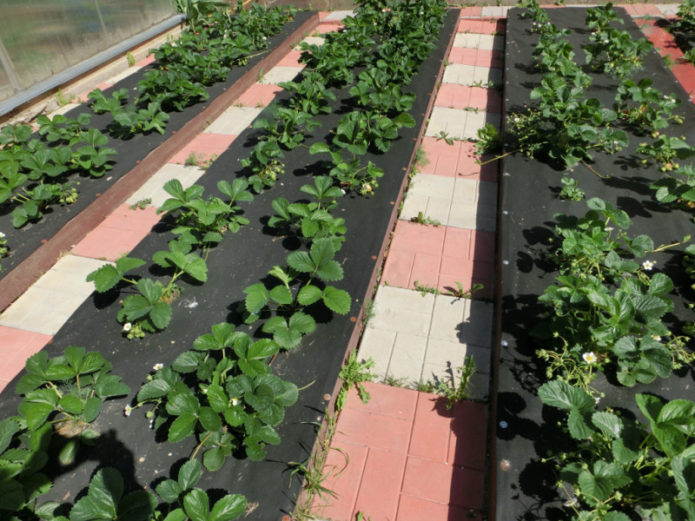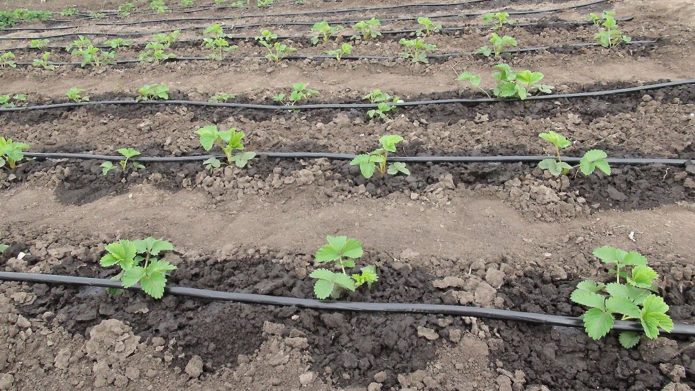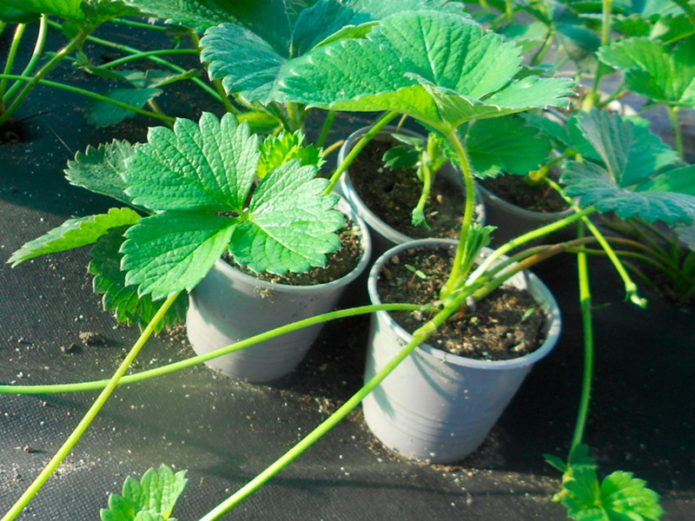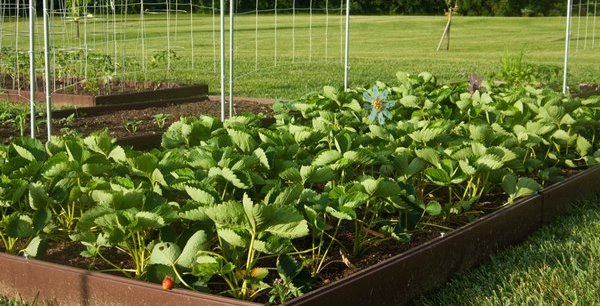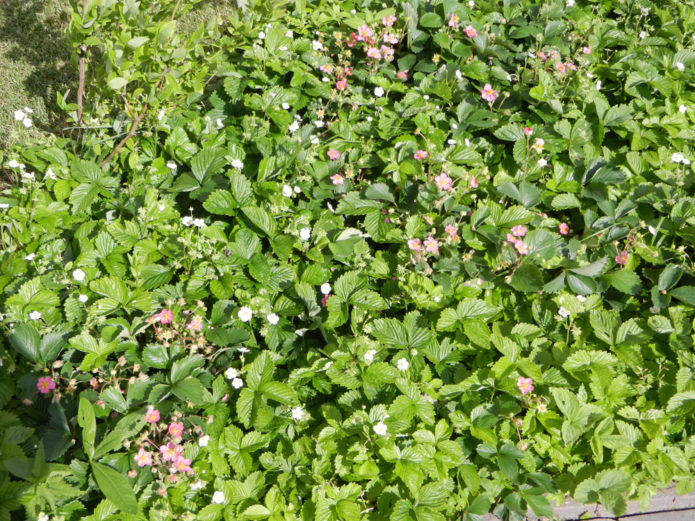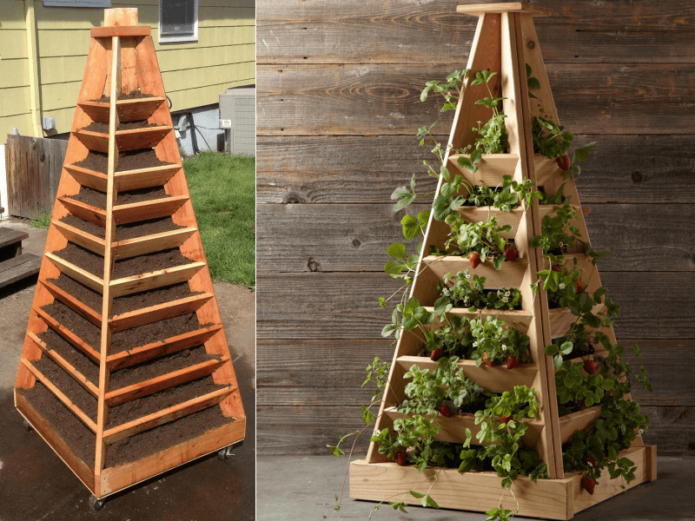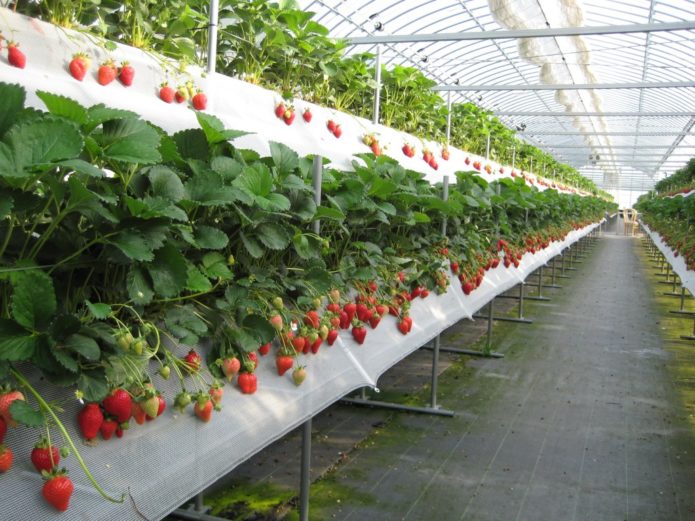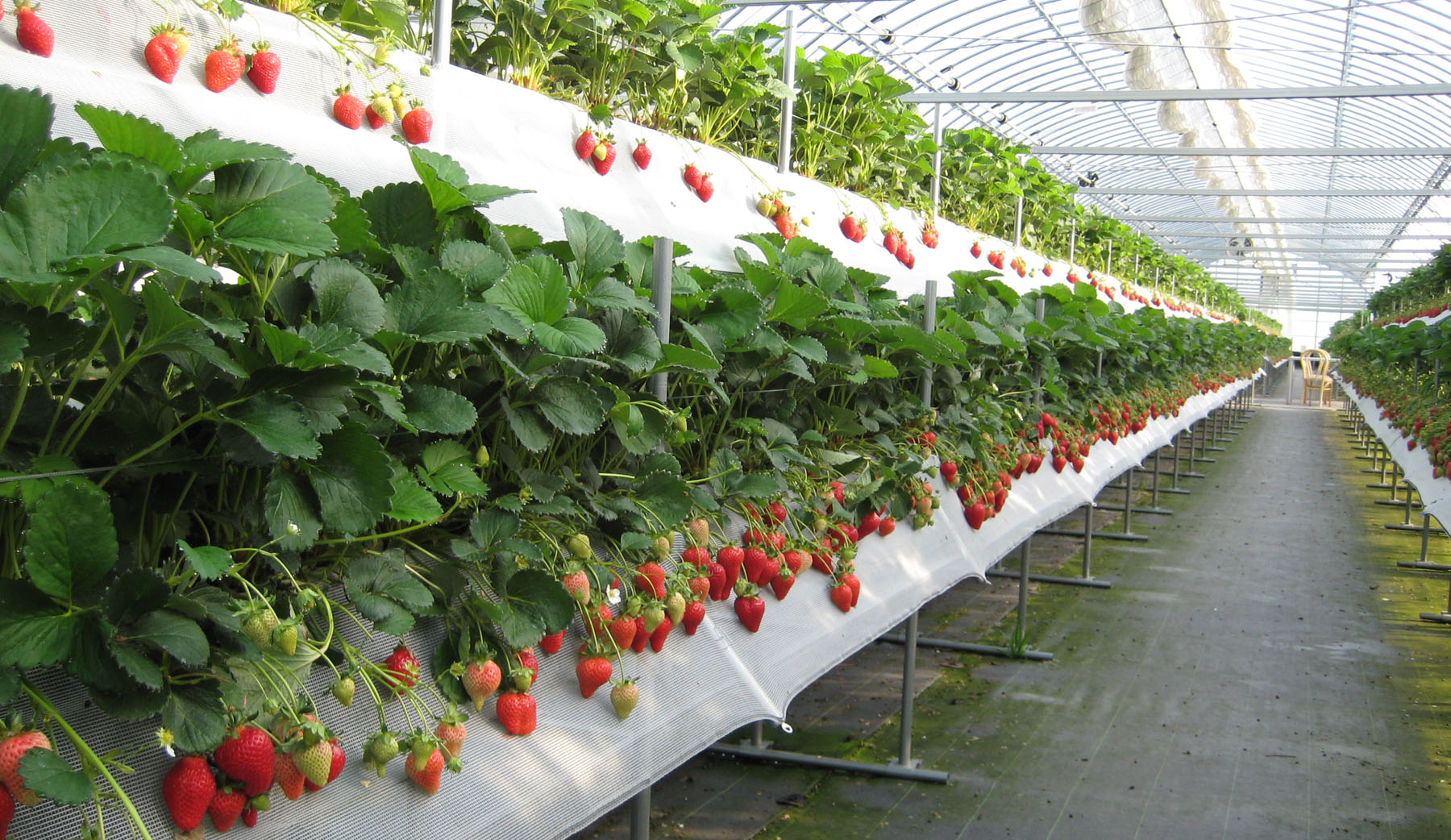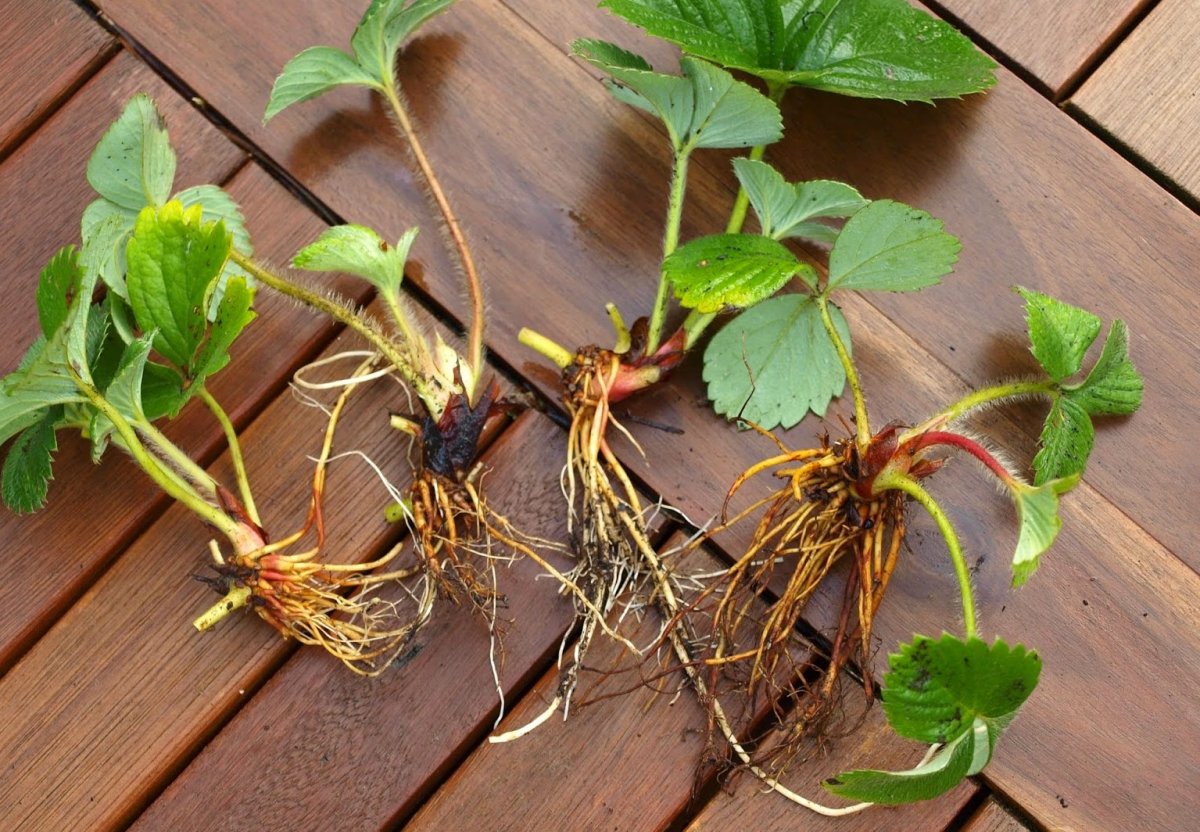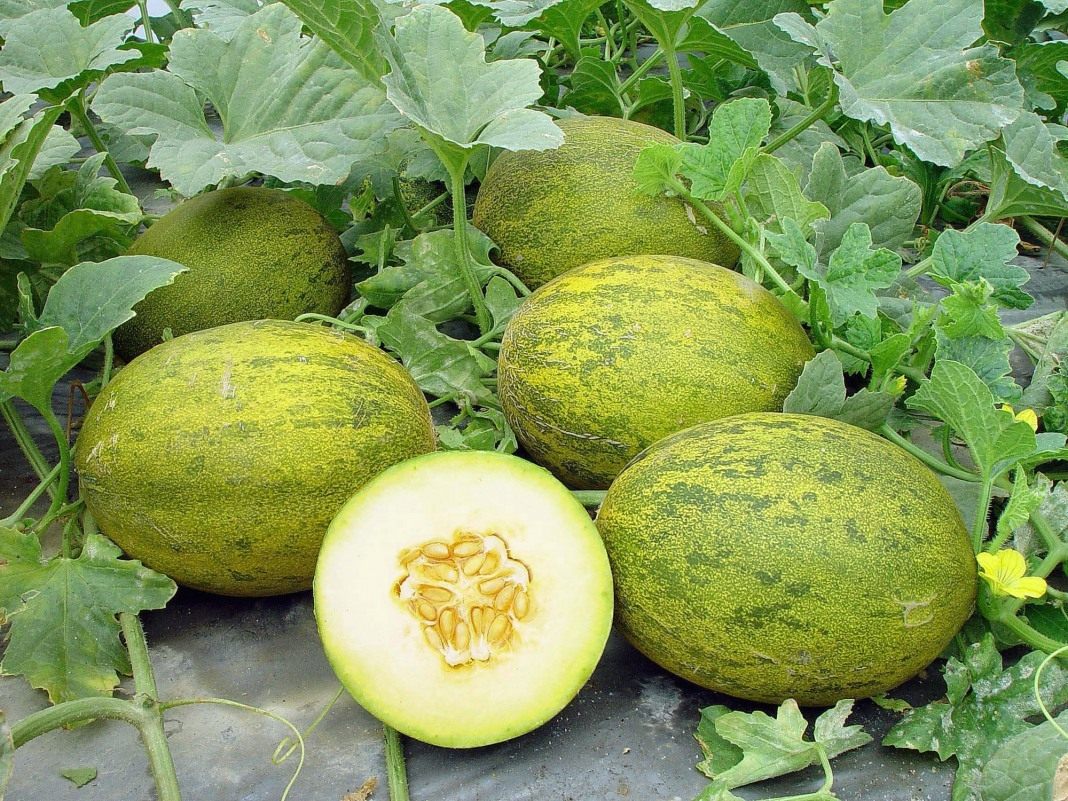Strawberries (garden strawberries) are a favorite berry that grows in almost every summer cottage. After all, it ripens quite early, when we are not yet satiated with vitamins, we still really want something tasty. Juicy, elegant, right from the garden - delicious! But it requires a lot of work. Let's consider what needs to be done to make strawberry plantations delight us, and the harvest from them - our children and grandchildren.
Content
Strawberry cultivation technology (garden strawberry)
Strawberry is a perennial plant. Once planted, it will grow for many years. True, in 3-4 years the harvest will decline, and problems for the gardener and summer resident will increase, and new beds will need to be planted. But the landing is only the first stage. This delicious berry requires constant care; Without the application of effort and effort, nothing good will come of us.
Choosing a place for strawberries on the site, the best and worst predecessors
In order for the care of strawberries to be not entirely a burden, it must first of all be properly planted. Various soils are suitable for strawberries: chernozem, loamy and sandy loam, but always well filled with organic and mineral fertilizers. The protection of the beds from cold winds is very important, which ensures a safe wintering and good development of strawberry bushes.
Dry and, conversely, too wet areas are not suitable for growing strawberries. Groundwater should not come closer than 1 m to the soil surface.
The terrain should be relatively flat. Planting on small slopes is possible, but it should be remembered that in low places strawberries suffer greatly from frost.
The optimal precursors for strawberries are radishes, various green crops, beans, peas, onions, garlic, and carrots. Raspberries and any nightshades (potatoes, tomatoes, peppers, eggplants) are unsuitable.
Soil preparation for strawberries
Strawberries can only bear fruit well in well-cultivated, loose and airtight soil with moderate acidity (pH 5.0–5.5).
Before planting strawberries, liming the soil is carried out in advance if it has high acidity. But this should be done at least a year before planting.It is better to dig a garden bed for future planting 2-3 weeks before them, so that a biological balance can be established in the soil.
When digging, it is best to add well-rotted manure to the soil. If there is no manure, it doesn't matter. One of the best ways out of the situation is to pre-sow green manure (vetch, peas or oats) on future strawberry beds. After moderate regrowth, without waiting for the formation of seeds, they are dug up with the ground with the preliminary introduction of full mineral fertilizers. This approach turns out to be low-cost and does not clog the soil with weeds, the seeds of which are usually found in abundance in not very old manure.
Landing scheme
Strawberries can be planted in different ways. The choice of a planting scheme depends on the region, the relief of the site and the preferences of the gardener himself. When planting strawberries in the generally accepted time frame, plants are usually planted with at least 60–70 cm spacing between rows, and 10–30 cm between bushes in a row (depending on the variety).
Some gardeners prefer to trim each bush when leaving, removing all growing mustaches, others grow strawberries in a narrow-band system. The latter means that the mustache is rooted, without separating it from the uterine bush, along the main row. In this case, the total strip is about 30-40 cm. In any case, it is necessary to achieve survival of all plants, observing the correct planting technique.
Strawberries should be planted during the cool part of the day, in cloudy weather. If it is still hot at this time, then it is better to cut off the lower leaves of the seedlings, and then shade the bushes with any available materials for about a week. The first time the planted seedlings should be watered more often.
What can be planted next to strawberries
Almost everything can be planted next to strawberries, except for plants that give a lot of growth: raspberries, plums, cherries. As for vegetable beds, the best neighbors are basil, salads, marigolds, beans, onions and garlic, any green crops.
Good results are obtained by the proximity of strawberries with tomatoes, legumes, cucumbers, radishes, radishes, cabbage.
Garlic and onions release phytoncides, disinfecting the air and soil, and parsley scares away slugs. True, some believe that due to the pungent smell of garlic, bees will fly less, strawberry flowers will be less pollinated, but most likely you should not pay attention to this: this will definitely not bring a significant decrease in yield, and the protective effect of onions and garlic is obvious ...
Planting dates for strawberries
Planting dates are highly dependent on the climate of the region. So, in the southern regions, it is better to plant strawberries in spring, from the end of March to May 5-10. The October landing is also quite good in the south. In the middle lane, strawberries are planted in late summer (until September 10), in the northern regions - from July 20 to August 15 or in spring.
Fertilizers applied during planting and feeding
For digging, organic matter is necessarily introduced - humus, compost, adding mineral fertilizers to them - phosphorus and potash.
On soddy-podzolic soils, before planting strawberries, you need to add 1 m2 8-10 kg of compost. Phosphorus and potash fertilizers are applied in a dose of 5 to 10 g of active ingredient (depending on soil fertility).
Fruiting strawberries are fertilized in the spring with nitrogen fertilizers, and in the fall - with phosphorus and potassium fertilizers (3-5 g of active ingredient per 1 m2).
All types of nitrogen and phosphorus fertilizers are suitable. Of the potash, species that do not contain chlorine are preferable (potassium sulfate, potash, wood ash). Foliar dressing (spraying of plants) has a positive effect on strawberries: at the beginning of flowering and during the growth of ovaries with 0.01% zinc sulfate solution, in August with 0.3% urea solution.
You can also use bird droppings or mullein for feeding. However, if in the case of a mullein, its excess does little harm to the plants, then in the case of chicken and, especially, pigeon droppings, one must be careful.You should use very highly diluted solutions, otherwise you can burn the plants. For 3-4 running meters, they take no more than a bucket of solution; no more than a handful of droppings are bred per bucket. Wood ash also gives excellent results: up to 150 g per square meter of the garden.
Watering strawberry beds
Forced irrigation is necessary in areas of insufficient moisture (although, of course, this is a significant part of our country). Watering is especially necessary during the ripening of the crop.
Before planting, the beds are usually watered by sprinkling, already planted bushes should not be watered this way, since hearts can be drawn into the ground. When planting, the soil is well pressed with fingers to the roots, and if it was not wet enough, carefully watered each bush from a bucket. When watering, one bucket of water is consumed for 10-15 plants. A few days later, the young plantings are watered again.
It is easy to understand whether urgent watering is needed by the appearance of the bushes: the leaves droop strongly in the heat. It is necessary to water with not too cold water (above 15 aboutFROM). The best way is along furrows, but in too hot weather you can use sprinkling.
With drip irrigation, excess water is not consumed, since, unlike watering directly from the hose, it flows to the roots. Row spacing is not watered and weeds grow less. However, in-store drip systems are often not cheap. However, you can do something similar with your own hands. For example, in an ordinary hose of the required length, make holes with a diameter of 1–2 mm strictly along one line. One end of the hose must be plugged, the other must be connected to a container with water. For the water to flow directly to the roots, the holes must be turned towards the ground.
Strawberry care during the season
Strawberry care is almost constant. Immediately after the plants emerge from under the snow, the beds are cleaned from dry and diseased leaves, followed by their burning. The collected plant parts are burned. At the same time, mulch is removed from the beds and scattered around the garden, after which it is dug up with soil and fertilizers.
In the budding phase, strawberries can be fed with complex mineral fertilizer. When expecting strong frosts, cover the beds with non-woven material (spunbond, lutrasil, etc.). Can be used for mulching beds of needles of coniferous trees. Before flowering, they cover the entire soil between the bushes with a layer of 3–6 cm. With this approach, the need for watering and loosening is significantly reduced. After harvesting, the needles are collected and burned.
On plantations over 2 years old, it is easiest to mow all the leaves after harvest. Mowing is carried out on August 1, since it takes about one and a half months for the reliable growth of new leaves. All unnecessary whiskers, as they appear, should be immediately removed, leaving only on the mother bushes (that is, those that will later serve as seedlings).
At the end of summer, plantations are struggling with weeds, loosen the soil. You can pour humus on the beds. In early August, in the middle zone of the Russian Federation, beds are prepared for new plantings.
With poor development of plants during the summer, they can be fed in August. This can be done with mild solutions of mullein or bird droppings. Foliar dressing is also effective, for example, with a 0.3% solution of urea or a weak solution of trace elements (0.2% each of potassium permanganate, boric acid and ammonium molybdate).
In autumn, the soil is dug to a depth of 20–40 cm. The soil under the bushes and in the aisles is mulched with humus or semi-rotted manure with a layer of about 5 cm. The bushes that have come out of the ground are slightly huddled to cover the bare roots. Continue to remove unnecessary mustache. Weeds that grow between rows in autumn do not need to be weeded: they will contribute to the accumulation of snow.
In late autumn, shortly before the onset of stable frosts, snow retention measures are carried out.If it's dry autumn, winter watering is carried out in October.
Strawberries are the most delicate berry in relation to frost from those grown in summer cottages. Lowering the soil temperature to -10 ° C leads to significant root damage. Uncovered plants often die at -15 ° C. Strawberries are well protected from freezing by snow. In snowless winters, strawberries are protected by adding mulch to the bushes (a layer of at least 10 cm), covered with spruce branches of coniferous trees. Shelter is performed when the temperature drops to -5–7 ° C.
Pruning
On strawberry plantations of the second year of life and older, after the last berry harvest, the leaves of the plants can be cut without touching the horns. After that, the bed must be fed with nitrogen fertilizer, for example, ammonium nitrate (up to 20 g per 1 m2). All growing mustaches must be cut off immediately. The cut parts of the plants are collected and put into compost, and if they are affected by diseases, they are buried deeply or, much easier, burned.
Leaves are cut with a pruner or oblique at a height of 1-2 cm from the beginning of the growth of the horns. Mowing leaves after harvesting helps to enhance root growth, destroys most pests, is an effective measure in combating weeds, and increases yield.
Strawberry propagation
Most often, strawberries are propagated in a vegetative way - by seedlings, that is, by rooted rosettes that form on the mustache. Seed propagation is more time consuming and does not always lead to success.
Seedlings with 3-5 well-developed leaves and roots no shorter than 6-8 cm serve as a planting material. It is better to get planting material from young plants, since they are not yet so sick, and also grow a mustache intensively. The author of these lines takes a mustache only from the plants of last year's planting. If possible, you should use the first mustache from the mother plant, the maximum - the second. Moreover, the earlier in the summer a new rosette of leaves forms and takes root, the more productive the new plant will ultimately be.
At first, the rosettes have only leaves, and near the ground, the rudiments of roots in the form of inconspicuous tubercles. In contact with the soil, the rosettes take root.
When growing mother plants, the beginning of the separation of the first rosettes can begin as early as June. However, few ordinary summer residents specially grow seedlings, usually an ordinary amateur starts working on rooting a mustache for new plantings after the harvest.
Strawberry seedlings are often obtained without separating the rosettes from the mother plants, but by rooting them practically where they grew, that is, in the aisles. But what can I say: after all, usually we do not have time for this either; the whiskers manage to take root on their own, where necessary, and when laying new plantations, we dig out the best of them and remove the unusable ones.
Protection from pests and diseases
At the summer cottage, it is better to fight pests and plant diseases, of course, without chemistry, but in difficult situations it is sometimes difficult without this. For example, with a high number of ticks in early spring, they are sprayed with chlorophos or a 3% Bordeaux mixture. This mixture also works against stains. However, you should not use it again: the accumulation of copper salts in the soil can only harm your health.
When the inflorescences are advanced and the buds are separated, spraying is carried out against a complex of pests and diseases with a mixture of chlorophos and colloidal sulfur. In terms of dosage, you must strictly follow the instructions for use, which must be attached to the drugs.
During the flowering period, in case of strong development of gray rot, you can spray the strawberries with copper chloride.
The slugs in the strawberry beds have to be picked by hand. This is often the most unpleasant and time-consuming procedure, but you cannot do without it: these nasty animals will devour your entire crop!
Features of growing strawberry seedlings
An ordinary Russian summer resident rarely specially grows seedlings, but if you set such a goal for yourself, you need to start uterine plots in the garden. This work is painstaking, therefore, with a lack of time, we simply systematically monitor the condition of our main bed.
When trimming the mustache, which has to be dealt with constantly, the strongest and closest to healthy bushes, that is, the mustaches that are the first "children" of this bush, should not be touched. Well, do not touch them at all: they should be turned in a direction convenient for us, where there is room for their successful growth. You can immediately help the mustache to take root: even if the roots have not appeared, pin the young mustache to the wet soil.
When it seems that the mustache is well rooted, since several large healthy leaves have already grown on it, it is worth tugging lightly on it. If it sits firmly in the ground, you can give it independence by cutting it off from the mother bush. There is a ready-made bed - we transplant. No - let it grow up in place for now.
Storage of planting material before planting in the ground
If you can't plant strawberry seedlings in the near future, you can store them in the refrigerator. For this, the plants are dipped in water, placed in a wet state in a plastic bag and tied tightly.
Generally speaking, strawberry seedlings can keep well for several months. To do this, it must be kept at a temperature of about 0 ° C, which is often used for spring planting. Healthy bushes should be dug out at the end of October, shaken off the ground, cut off old and damaged leaves, leaving only 1-2 young ones, put in a plastic bag and tie it tightly. The most important condition is not to dry the plants, so you need to check them from time to time.
Before planting, the seedlings should be disinfected, which is easiest to do by placing the entire bushes in water heated to + 40-48 ° C for 10-15 minutes.
Strawberry cultivation methods
What did our summer residents not invent, trying to grow strawberries in a variety of conditions, sometimes, it would seem, completely unsuitable for this demanding berry, in a limited space!
Video: helpful tips
In high beds
Usually, high beds have to be built in conditions of high humidity, in swampy places. In such areas, it happens that there is water in the furrows almost all summer. Therefore, the bed is raised above the furrow by 20-30 cm.
Such a bed can be fenced off with a frame made of boards or any sheet material, or you can leave it unfenced. Of course, with a frame it is much more stable, but without it it will crumble.
In regions with little snow, a problem for strawberries on high ridges may be the possibility of winter freezing, therefore, if the snow height is less than 30 cm, in autumn it is necessary to create additional shelter with straw, spruce branches or spunbond.
Tall beds are prepared long before planting, taking into account the possibility of strong soil subsidence during irrigation and rotting of organic fertilizers, which in this variant have to be added to the soil in increased quantities.
In the ridges
This growing method, also used in areas with a lot of rainfall, is more suitable for large-scale production, since it is very difficult to prepare the ridges correctly without the presence of equipment.
The ridges are created just before planting, the height of each should be 25-30 cm. Planting is carried out after watering. You can plant strawberries and, as it were, "in the side" of the comb. The combs are placed 70 cm apart, strawberries are planted on both sides of each in a checkerboard pattern.
When growing strawberries on the ridges, reasonable quantities are supplied to the roots, the bushes are constantly ventilated, which prevents the development of diseases. With this method, it is convenient to care for the plantation.
Carpet growing
It is believed that this method of planting strawberries was invented by lazy people.In fact, many are simply not able to often visit their dacha for various reasons. And with carpet planting, the care, of course, is not so thorough. But excellent harvests are not to be expected either. So we don't need much!
With this method, the planted strawberries, growing, cover the entire space allotted to it with a solid carpet. The mustache is not trimmed, and new bushes grow randomly from the outlets. Plants create their own microclimate. At the same time, fewer weeds grow, less water and evaporates. The trouble is that with this method of cultivation, the berries quickly become smaller. However, they taste no worse, and sometimes even sweeter. It happens that a strawberry carpet grows up to 10 years, until the owner finally gets his hands on planting a new bed.
In vertical beds
When growing strawberries vertically, space is saved, and plantings are less damaged by diseases. Vertical strawberry beds are made from various materials at hand. Each of them has its positive and negative sides.
Growing in a pyramid
Planting strawberries in a pyramid is one of the methods of vertical cultivation. Pyramids are made, as a rule, from boards, although any options are possible. The finished structure resembles a pyramid, and strawberries are planted in several tiers. The method is most suitable for remontant varieties and ampelous varieties.
Flower bed cultivation
A pyramid-shaped flower bed is most often used when growing ampelous strawberries. Usually, a box is made of the required size, but at least 30 cm high, and soil is poured into it. Several more boxes are hammered together without a bottom of the same height, but of a smaller area. They put them on top of each other in the form of a pyramid and pour the earth. Strawberry seedlings are planted in all boxes at intervals of up to 20 cm.
In tires and five-liter bottles
Sometimes pyramidal strawberry beds are made from wheel tires. The structure can be of any height, while the metal cord acts as a frame. The essence is the same as in the case of wooden boxes: several tires (from 3 to 5) of the same or different sizes are used. The tires are placed in a vertical shape (cylinder or cone, depending on the size), sequentially falling asleep inside the soil. Previously, holes are cut in the tires, into which plant seedlings are subsequently planted.
You can use plastic bottles with a capacity of up to 5 liters. They are placed on suitable vertical supports. It can also be a regular garden metal mesh. Cut off the bottom of the bottles, close the lids so that there is a crack for the flow of water. Holes are cut in the bottles, where the seedlings will then be planted. Fill bottles with soil and plant bushes. The bottles on the support are placed one into the other. When watering, water seeps through the entire vertical bed.
In pots, planters and flowerpots
If you have pots of different diameters, they can also be used to equip vertical beds. In this case, the pots are placed on top of each other in the same way as they do with bottles, tires, etc.
Growing seedlings from seeds
There are several of the most popular ways to get seedlings from seed.
In peat tablets
Peat tablets are a convenient modern substrate for growing seedlings from seeds. They are made in the factory by pressing peat with the addition of mineral fertilizers and biostimulants. For strawberries, tablets with a diameter of 24 to 33 mm are convenient. The seeds are soaked, hardened and sown in tablets in early March. Further care is the same as for any seedlings. In summer, the bushes are planted on the garden bed together with the pill, so the growth practically does not stop, and the pre-seasoned strawberries do not experience any stress at all.
In a snail
Cut a 12 x 100 cm strip from any durable sheet material such as linoleum.It is placed on the table, wet soil 1–2 cm thick is poured, tamped slightly, and a strip of earth is rolled up in the form of a tube. It turns out a cylinder 12 cm high. This is called a "snail". The end of the strip is fixed with tape.
The seeds are planted in the ground over its entire area, with a distance between the seeds of 1–2 cm. Then they are covered with a film, put in a warm place and wait for the emergence of seedlings. Care - as for any seedlings.
In bags and barrels
For growing strawberries, regular "potato" bags are often used. A bag made of dense polyethylene is placed inside it. However, just a plastic bag is enough, which just needs to be reinforced with strong ropes. Then everything depends on the gardener's imagination. It is only clear that the bag must be filled with soil and holes made in it for the bushes. But many people try to maintain aesthetics in this case too, by landing not just in holes, but in specially made pockets.
Vertical strawberry beds are often made from wooden barrels. Holes are cut out on the sides of the barrel, strawberries are planted and simply on the upper plane of the barrel. You can use several barrels, placing them relative to each other in any nice way, in that one on top of each other. The advantages of a wooden barrel are that the tree does not overheat, it looks beautiful in the garden. However, they are short-lived, and are unlikely to rot in the next 6-8 years. Iron barrels get very hot and don't last longer.
In boxes and boxes
If the plot is small and there is no space in the beds, you can just grow strawberries on the street in boxes. True, wooden boxes are short-lived, and with their small size it is difficult to properly organize watering and achieve the required soil moisture. But you can also use plastic ones. Of course, by drilling holes to drain excess water.
The boxes can be positioned in any way, including vertically, hanging on the walls. It is only necessary to put a drainage layer on the bottom (about a quarter of the height of the box). The rest of the agricultural technology is common.
Growing in hydroponics
The essence of the method is growing a plant without using land. There are various artificial media used in place of soil.
Of course, in this way it is possible, in theory, to grow strawberries, but it hardly makes sense at a summer cottage. After all, such a technique requires constant watering with a special solution containing all the nutrients. The method is quite capricious, but it can be recommended if you want to get berries in the winter, in a city apartment.
Growing under agrofibre
On a bed covered with non-woven material, weeds practically do not grow, and the soil retains moisture better. The most common covering material is polypropylene spunbond, available in various basis weights. When growing strawberries, a density of at least 60 g / m is required2 so that the material will withstand 2-3 seasons of use.
Strawberries grown under agrofibre are most often planted on ridges. This technique is best suited for regions with humid climates and warm winters. Spunbond allows you to significantly reduce the amount of watering: even in the heat, water is retained in the garden for 5-7 days.
Finnish technology
The essence of the technology adopted in Finland is that the soil is covered with a black film. This technology allows you to pick berries 2 months after transplanting. The reason for this is fast and high-quality heating of the soil. In addition, the Finnish method prevents weeds from growing.
For this method of growing strawberries, it is necessary to arrange a drip irrigation system. The irrigation hose is pulled along the entire bed, small holes are made in it and buried in the ground at a shallow depth.
Growing on shelves
Growing strawberries on shelves is sometimes referred to as Dutch technology. This is done in the northern regions when using greenhouses.The most convenient is a polycarbonate greenhouse - arched or with a pitched roof with windows for regular ventilation.
To ensure sufficient illumination, the greenhouse is equipped with fluorescent lamps. In addition, good heating is required. Strawberries are grown in boxes of various sizes, which are placed on the shelves. Boxes, in particular, can be made from unnecessary wooden pallets.
Features of growing strawberry mother liquor
On the mother plot, strawberry seedlings are located quite freely. So, up to 70 cm of unoccupied space is left between the rows, mulching these gaps well to create a constantly moist substrate. In rows, bushes are planted at a distance of 30 cm from one another. The healthiest and strongest seedlings are chosen to create mother beds.
The mother plot should only exist for one year, after which it should be considered an ordinary bed and berries should be collected from it.
If the mother plants are covered with plastic wrap in early spring, then you will have a good seedling by the beginning of summer. And the earlier you plant strawberries in the summer, the bigger your harvest will be next year! To speed up the formation of a mustache and get stronger seedlings, peduncles must be systematically cut out from the mother bushes.
The sockets are rooted directly on the mother beds or in separate greenhouses specially built for this purpose. After picking the sockets, watering is carried out, and the bushes are shaded for a couple of days with plain paper or other improvised material. Planting is periodically watered, it is possible by sprinkling.
Good rooting requires high humidity. Therefore, to accelerate the growth of seedlings, sometimes the beds are covered with a film, which must be stretched over the arcs. Usually after a month, the seedlings are ready for planting in a permanent place. During this time, you can feed the plantings with full mineral fertilizer 1-2 times.
Features of agricultural technology of strawberries in the regions
The technology of growing strawberries in all regions is practically the same, but the climate makes significant adjustments to the timing of a particular stage, in particular, planting seedlings. In addition, in different regions, it is necessary to water the beds less often or more often, pay more or less attention to preparing the plantation for winter.
So, for example, in the Krasnodar Territory, in a warm humid climate, strawberries grow almost all year round. In the area of the Black Sea coast, high yields can be obtained almost without additional irrigation. Sufficient rainfall allows you to successfully grow strawberries in the aisles of young orchards.
Weather permitting, strawberries can be planted here until winter. From the point of view of preparation for winter, no preparatory work is required here: ordinary weeding and loosening.
In Ukraine, the conditions for growing strawberries are also good, but the likelihood of bad weather is much higher. Depending on the region, this rather large country can have both overly hot periods and rather rainy seasons. However, in general, we can say that there are no big problems with caring for strawberries in Ukraine. It does not exist so much that in recent years many have been trying to build their business on it, and it mostly brings profit.
Mostly strawberries are grown in the central, western regions of Ukraine and in the south. Leaders in commercial production - Vinnytsia, Khmelnytsky, Cherkasy, Odessa, Kherson regions. In the Kharkov region, gardeners believe that the drip irrigation method is the best for obtaining a high yield. The beds here are often covered with black agrofibre, solving problems of weed control, as well as protecting the berries from dirt.
One of the tasks of strawberry breeding in the south of our country is to breed heat-resistant and drought-resistant varieties.So, in most regions of the North Caucasus, summer is very hot, but precipitation is often not enough, so special attention must be paid to watering.
Strawberries are usually planted in this region in October. The main landing pattern here is a narrow-band one, that is, a distance of 0.7–0.9 m is maintained between the rows, although in recent years other commonly used schemes have been practiced. In the conditions of the North Caucasus, dry winds cause great harm to strawberries. Therefore, it is necessary to create windbreak plantings here.
In the Far East, and, in particular, on Sakhalin, growing strawberries is possible, but rather risky. Here you must be very careful when choosing varieties. Often, remontant varieties are planted here, from which you can harvest 2-3 crops per season. Weather conditions require you to take seriously not only care for strawberries during the growing season, but also, most importantly, to properly prepare them for winter, to save from frost.
In areas with little snow at the end of October, with the establishment of stable frosts, strawberries are covered with straw, reeds, tops of up to 10 cm.However, the most reliable method is growing in greenhouses, which the Japanese have long and successfully used on one of the neighboring islands - Hokkaido.
Strawberries in their summer cottage require a lot of effort. Unfortunately, it is impossible to grow a good harvest without this. But how nice, having collected it, immediately treat yourself to a delicious vitamin berry! Probably, it still makes sense to get involved with planting strawberries and caring for them. The article attempts to highlight the highlights of the battle for this much-needed crop.
